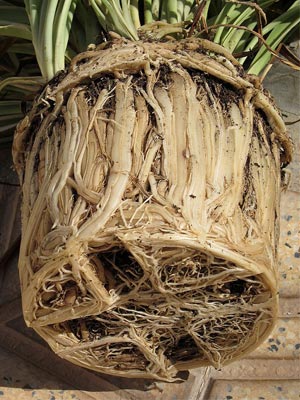Introduction
Container gardening offers flexibility and control, but it also comes with challenges—especially when it comes to your plant’s root health. Over time, plants grown in pots can outgrow their containers, leading to tangled, circling roots. This condition, often referred to as root bound or pot bound, can cause stress, nutrient deficiencies, and even plant death.
So, can you cut plant roots? Can you trim roots on a plant without killing it? Absolutely—when done properly. This guide will walk you through the how and why of root pruning, including when it’s necessary, what tools to use, and how to do it safely.
What Is Root Pruning?
Root pruning is the process of cutting or trimming a plant’s roots to manage growth, maintain health, and prevent container-grown plants from becoming root bound or pot bound. As plants grow, their roots seek more space. In a container, this often leads to circular root growth around the pot’s interior—eventually compacting and choking the plant.

Root Bound vs Pot Bound: What’s the Difference?
The terms root bound and pot bound are often used interchangeably, but there’s a subtle distinction:
- Root bound refers to the condition where the roots have filled up the entire pot, circling and tangling.
- Pot bound typically implies the plant is confined in a container that’s too small, which can lead to root bound conditions if not addressed.
In either case, pruning roots becomes essential if the plant can’t be up-potted or transplanted in time.
Should You Trim Roots?
Yes, in many cases, you should trim roots—especially for long-term container plants or when transplanting seedlings that are already root bound. But don’t worry, when done properly, root pruning potted plants can actually invigorate growth.
So, can you cut roots off a plant? Yes. Can you trim plant roots safely? Also yes—but with the right techniques and timing.

Let Your Container Do the Root Pruning
One of the easiest ways to prevent root bound issues is to choose containers designed to naturally prune roots.
Air Pruning
Air pruning happens when roots reach the edge of breathable containers like fabric pots (e.g., Smart Pots). Contact with air causes root tips to dry out and stop growing, stimulating the plant to grow new, healthy roots deeper inside the soil.
Browse breathable, air-pruning planting containers.
Light Pruning
With white grow bags or containers that allow some light penetration, light pruning occurs. Roots at the container's edge are exposed to light, triggering a stop in their outward growth. This mimics natural root behavior, preventing spiraling or girdling.

How to Trim Roots: Root Pruning by Hand
If your plant is already root bound and you can't transplant it into a larger container, manual root pruning is your best solution.
Step-by-Step: Pruning Roots by Hand
-
When to Prune Roots
- For established container plants: every 2–3 years as maintenance.
- For transplants: if roots are circling at the time of planting.
- If a plant is visibly root bound: prune immediately.
-
Remove the Plant Safely
- Gently tip the pot on its side and slide the plant out by gripping near the base.
- If stuck, use a harvest knife or pruning tool to loosen the soil edges—never yank the plant.
-
Cut the Roots
- Trim away the outer layer of compacted roots using a hori hori or shears.
- Can you cut plant roots that are circling? Yes—this encourages outward root growth.
-
Tease Apart and Trim Feeder Roots
- Use a root cultivator like a Cobra Head to tease apart roots.
- Can you trim roots on a plant with a taproot or bulb? Yes, but avoid cutting the main root structure. Focus on small feeder roots.
-
Repot the Plant
- Replant at the same depth using fresh potting mix—not the old soil with trimmed roots.
- Add an organic fertilizer or root booster to support recovery and nutrient uptake.
-
Aftercare
- Water thoroughly and apply a liquid kelp or seaweed-based tonic.
- Keep the plant in indirect light for a few days to reduce transplant shock.
Benefits of Root Pruning
- Prevents stress and starvation from root crowding
- Promotes healthier, more efficient root systems
- Stimulates new growth and higher nutrient uptake
- Extends the life of container plants
- Reduces need for frequent repotting

Conclusion
Root pruning isn’t just safe—it’s essential for long-term container gardening success. Whether you're growing houseplants, tomatoes, or small trees, knowing how to trim roots and when to do it can make the difference between a struggling plant and a thriving one.
So next time you wonder, can you cut plant roots or can you trim roots on a plant—you’ll know the answer is yes, with care, the right tools, and a little know-how.
Get everything you need for successful root pruning at Grow Organic:
Make your container plants healthier, happier, and longer-living—one root trim at a time.
FAQ: Root Pruning Container Plants
-
Can you cut plant roots without killing it?
- Yes! As long as you don’t remove more than one-third to two-thirds of the root mass (and avoid cutting the main taproot), root pruning is safe and beneficial.
-
Can you trim roots on a plant when transplanting?
- Yes, especially if the roots are circling. Trimming them will help the plant grow better in its new home.
-
Should you trim roots when repotting?
- If your plant is root bound, yes—you should trim the roots before placing it into a new container to encourage outward growth.
-
Can you trim plant roots every year?
- Not necessarily. Most container plants benefit from root pruning every 2–3 years. However, some fast-growing species may need it more often.
-
How do you know if your plant is pot bound?
- Check for roots poking out of drainage holes or spiraling around the root ball. If the plant dries out too quickly or shows signs of nutrient stress, it may be pot bound or root bound.

